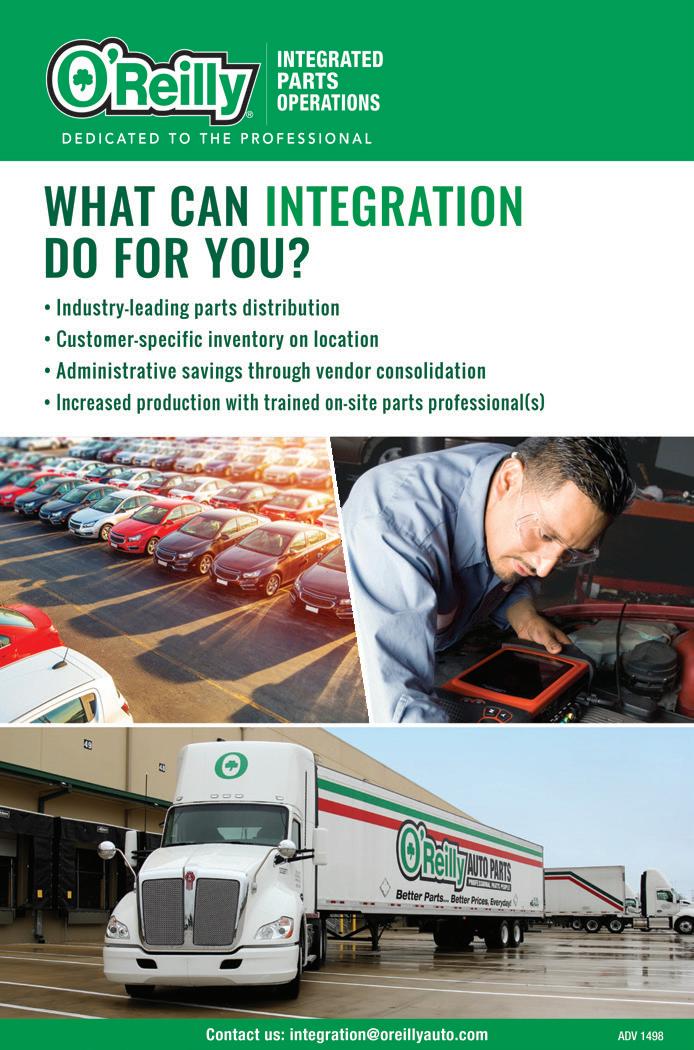
8 minute read
Legal Corner: After-Sale Repairs: Keeping Them Running
After-Sale Repairs: Keeping Them Running
One of the more quaint phrases used by buyhere-pay-here dealers in the ancient past was: “If they ain’t driving, they ain’t paying.” The rustic wisdom of that saying holds true today. In the world of subprime motor vehicle finance, but especially in the BHPH business, it is often necessary to assist customers in getting repairs done. It is also often in a dealer’s best interest to be involved in the process of analyzing breakdowns and referring customers to preferred repair shops to prevent such unpleasant occurrences as abandonments and the placement of mechanic’s liens.
At one time, almost all dealerfinanced sales were on an “as is” basis. But in recent years, more and more dealers have gone to offering some type of warranty on their vehicles and others are offering to sell commercial service contracts, adding the charge to the amount financed in the installment contract. What are some of the ways dealers can address postsale repairs as part of the sales transaction?
When it comes to discussing warranties and service contracts, it’s necessary to understand the definitions of the key terms. Even though the terms “warranty” and “service contract” are often used interchangeably, they are actually different things.
As Is
This term refers to selling a vehicle (or any other product) without giving a warranty.
by
Michael W.
Warranty
Warranty is by definition an undertaking or promise given by
Dunagan
TIADA GENERAL COUNSEL
a manufacturer or seller of a product to repair or replace merchandise if certain defects occur. There is and can be no separate charge for a warranty.
An example of a warranty is the limited warranty given by automobile manufacturers on the new cars sold by their franchised dealers. There are no additional charges to the buyers, and the terms of the warranties are set forth in written documents given to the buyers.
The issuers of service contracts are required in Texas to be registered with the Texas Department of Licensing and Regulation (TDLR) and must meet rigorous financial requirements involving cash deposits and/or Service insurance backing of Contract Service contracts, the product. on the other hand, are insurance-like products sold to requirements involving cash decar buyers to provide or pay for posits and/or insurance backing of repairs that are not covered by a the product. warranty. Service contracts are usually offered by third-party SELLER OPTIONS providers and sold through car Selling As Is dealers (although some are directIt is still possible to sell a vehicle marketed to consumers). The on an “as is” basis. This means issuers of service contracts are that there are no warranties given required in Texas to be registered with the sale. While selling “as is” with the Texas Department of eliminates the threat of breach of Licensing and Regulation (TDLR) warranty claims, it doesn’t preand must meet rigorous financial clude claims of misrepresentation
and other violations under the Texas Deceptive Trade Practices Act. On an “as is” sale, the box on the Federal Trade Commission Buyers Guide form that says “AS IS — NO DEALER WARRANTY” should be checked. If a service contract is offered for sale, the box below that is labeled “SERVICE CONTRACT” should be checked to disclose the availability to the buyer of a service contract at extra charge.
Giving A Seller’s Warranty
If the decision is made to give a warranty to buyers, a dealer should acquire a warranty agreement that is labeled as “Limited Warranty” and that spells out the specific terms of the warranty (the FTC Buyers Guide is a disclosure document displayed on each used car offered for sale, and is not adequate to serve as a warranty agreement). The form should meet the requirements of the Magnuson-Moss Act and the FTC Used Car Rule.
Sellers have the flexibility to tailor warranties to fit their needs. For example, deductible amounts, a maximum dollar limit for repairs, the duration of the warranty, and the percentage of costs covered (such as a 50-50 split) can all be determined by the issuer of the warranty. Also, specified types of repair and
If the decision is made to give a warranty to buyers, a dealer should acquire a warranty agreement that is labeled as “Limited Warranty” and that spells out the specific terms of the warranty (the FTC Buyers Guide is a disclosure document displayed on each used car offered for sale, and is not adequate to serve as a warranty agreement).
ENSURE GROWTH, PROFITABILITY & LONG TERM CUSTOMER LOYALTY WITH OUR BEST-IN-CLASS SUITE OF PRODUCTS
• TIADA Approved CPO Program • Full Claims Administration • Limited Warranties • Collateral Protection Insurance • Vehicle Service Contracts • GAP Waivers
components can be excluded from coverage. (A limited warranty template form can be obtained from Burrell Printing Company at 800-252-9154.)
The warranty agreement must inform customers what steps need to be taken to invoke warranty coverage, such as whether the vehicle must be brought to the dealer for warranty work. Most warranties exclude coverage of damage caused by abuse or misuse of the vehicle.
Additional rules apply to what must appear in a written warranty agreement. There are, for example, certain required disclosures that must be placed on written warranty agreements. One such mandatory disclosure states: “This warranty gives you specific legal rights, and you may also have other rights which vary from state to state.”
In the spirit of pre-purchase disclosure of whether there is a warranty, and if so, what the terms are, the Magnuson-Moss Act requires that warranty agreements be made available for inspection by prospective buyers prior to sale.
Shifting from selling “as is” to selling with a warranty also requires changes to the Buyers Guide disclosure forms that are displayed on vehicles offered for sale. The purpose of the Buyers Guide is to advise potential buyers whether vehicles are being sold “as is” or with warranty; and, if they come with a warranty, whether the warranty is “full” or “limited.” Also, a brief summary of coverages provided by the warranty is included.
The Buyers Guide for each vehicle covered by a limited warranty should have a mark next to “Warranty” (as opposed to “As Is — No Warranty”), and a mark next to “Limited Warranty” with the percentages of labor and parts which will be paid filled in. A description of the systems covered, such as: “engine,” “transmission,” “drive shaft,” or “differential” should be filled in (use of the terms “drive train” and “power train” are forbidden as being too vague), and any rules on deductibles (such as “A $50 deductible applies to each repair visit”) should be disclosed. The Buyers Guide should show the duration of the coverage for each system. Commercial Service Contracts
Dealers are authorized under the Texas Finance Code to sell service contracts and to add the premiums to the amounts financed on motor vehicle retail installment contracts. The service contracts must be issued by companies that are registered with the Texas Department of Licensing and Regulation (TDLR) and the charge must be itemized on the installment contract in a way

that clearly reflects what the charge is for, to whom it is being paid, and the amount of the charge.
Purchase of a service contract is at the option or the buyer and can’t be required as a condition of sale. Most dealer management software packages will properly place the required disclosure information on the installment contract when the information is entered into the system.
Dealers are required to deliver a copy of the service contract to buyers at closing. The FTC Buyers Guide should be marked to reflect the availability of a service contract for purchase and, if the dealer is not giving a warranty, the “AS IS — NO DEALER WARRANTY” box should also be checked.
Dealer’s Service Contract
A TIADA-sponsored bill passed in the 2019 session of the legislature contained an amendment to the rules on issuing service contracts for vehicles that made it feasible for a dealer to issue and sell its own service contracts. A licensed dealer who sells service contracts only to his or her purchasers can obtain authorization from the Texas Department of Licensing and Regulation to issue service contracts with a reserve deposit of $25,000 (as opposed to $250,000 required of all other service contract issuers). The same rules regarding pre-sale disclosure that apply to commercial service-contract products apply here.
In addition to meeting the TDLR registration requirement, the dealer must have a service contract form that meets certain requirements in specifying what is covered and what buyers must do to make claims.

What Not To Do 1. Do not put a “warranty” charge on an installment contract.
Warranties come with the sale and are not subject to additional fees. 2. Do not issue warranties to buyers without appropriate warranty agreement forms. The FTC
Buyers Guide is not a warranty agreement form. 3. Do not put a service-contract charge on an installment contract if there is no actual service contract issued by a company authorized by TDLR. Examinations performed by Office of
Consumer Credit Commissioner personnel include review of installment contracts to determine if such unauthorized charges have been made.
Michael W. Dunagan is an attorney in Dallas, Texas who has represented the Texas Independent Automobile Dealers Association for over 40 years. He has written a number of books and hun dreds of articles for trade journals and law reviews. His clientele includes deal ers, banks, finance companies, auto auctions and credit unions.











